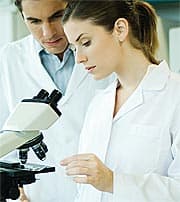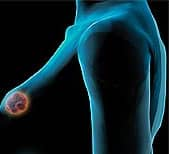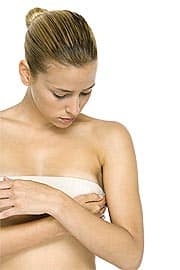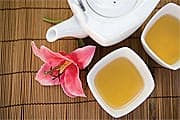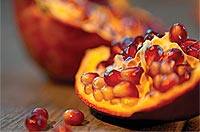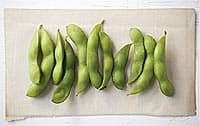Life Extension Magazine®
One of the most frightening events that a woman will ever face is being diagnosed with breast cancer. While many women diligently seek health screenings to catch this insidious disease in its early stages, few of us realize the cancer-preventive potential of nutrients such as vitamin D and pomegranate. These scientifically documented agents provide powerful protection against breast cancer through a number of fascinating mechanisms. By favorably affecting gene expression, pomegranate, green tea, curcumin, and vitamin D can restore healthy cell division patterns,1-4 while soy extracts can help guard against estrogen’s hyper-proliferating effects.5 One in eight women in the United States will be diagnosed with this life-threatening disease during her lifetime.6 Even with all the advances in pharmaceutical technology, mortality rates for breast cancer have remained stagnant for the past few decades. As the scientific evidence for natural cancer-protective compounds continues to mount, many of today’s leading scientists believe that a multi-pronged nutritional strategy holds the key in helping to win the war against breast cancer. The Epidemic of Breast CancerToday, breast cancer is the most frequently diagnosed cancer in American women, excluding skin cancer.7 This is in part due to earlier and more frequent detection with mammography and breast examination, but also due to increasing risk factors for breast cancer. These risk factors include delayed childbearing, having fewer children, use of pharmaceutical hormone replacement therapy, and obesity, especially in postmenopausal women.8 In the United States, an estimated 178,480 new cases of invasive breast cancer were diagnosed in 2007, along with more than 40,000 deaths, making breast cancer the second leading cause of cancer death in women.7 Natural Options for Preventing Breast CancerRecent studies offer hope that vitamin D and foods-beverages such as green tea, pomegranate, curcumin, and soy may help promote breast health and reduce breast cancer risk. These foods are rich in healthful compounds known as polyphenols, which are active in many pathways that regulate cell growth and metabolism. “Research has indicated these compounds have a potential not only in prevention of breast cancer but also for treatment,” Bharat B. Aggarwal, PhD, Ransom Horne, Jr., professor of cancer research at the University of Texas M.D. Anderson Cancer Center in Houston, tells Life Extension magazine. “Most of the natural products, including vitamin D, green tea, pomegranate, and curcumin, mediate their effects through modulation of multiple cell signaling targets.” “This is a big advantage because scientists are beginning to realize that multi-targeted therapies are needed for the treatment of cancer,” says Dr. Aggarwal, who is also a professor of cancer medicine in biochemistry, and chief of the cytokine research laboratory, Department of Experimental Therapeutics, at M.D. Anderson. “These natural products are designed to be multi-targeted naturally.” Cancer-Preventive Potential of Vitamin DVitamin D, created by the body in response to sunlight, and present in fortified milk, fish, and fish liver oils has long been touted as a natural preventive agent against bone loss seen with aging and the menopause. But can it also benefit breast health?
“Vitamin D seems to reduce cell division in many types of cells,” Julia Knight, PhD, associate professor of public health sciences at the University of Toronto, Ontario, Canada, tells Life Extension. “Too much cell division can lead to cancer development.” Dr. Knight, who is also a senior investigator and leader at the Prosserman Centre for Health Research, Samuel Lunenfeld Research Institute of Mount Sinai Hospital in Toronto, notes further, “Vitamin D is also important for other reasons such as for bone health.” Marilyn Tseng, PhD, an associate member of the Fox Chase Cancer Center, in Philadelphia, PA, agrees that numerous lines of evidence suggest that vitamin D might be protective against cancer. These include population studies showing lower breast cancer rates in areas of the US that get more sunlight, and laboratory studies showing that vitamin D has anticancer effects.9 In addition, epidemiological studies show that women with low vitamin D intake tend to have high breast density on mammograms, which is associated with increased risk for breast cancer.10,11 Lower amounts of sun exposure are also linked to increased breast cancer risk in light-skinned women.12 “The active form of vitamin D in the body (1,25-dihydroxyvitamin D) is thought to have several anticarcinogenic (anticancer) effects, including inhibition of cell proliferation and induction of apoptosis (natural cell death), Dr. Tseng tells Life Extension. Laboratory studies have shown that 1,25-dihydroxy-vitamin D suppresses growth of breast cancer by blocking signals that stimulate cancer cell growth, by enhancing signals that inhibit cancer cell growth, and by favorably altering regulators of the cell cycle.1 This three-pronged attack can prevent mutated cells from becoming malignant and even induce cancer cell death. In addition, vitamin D plays a role in the effects hormones have on breast cancer, including the potential stimulating effects of growth hormone and prolactin.13,14 Vitamin D may also help prevent or modulate breast cancer through interactions with the vitamin D receptor in mammary cells. By binding with the vitamin D receptor in healthy cells, 1,25-dihydroxyvitamin D influences proteins involved in cell differentiation, survival, and proliferation. The active form of vitamin D may discourage proliferation and promote differentiation in breast cancer cells that are vitamin D receptor-positive.15 In one investigation, scientists prospectively examined the relationship of vitamin D and calcium intake to breast cancer incidence. Higher intake of vitamin D and calcium was associated with a modestly reduced risk of breast cancer in premenopausal women. Interestingly, the protective benefits were more pronounced for more aggressive breast tumors.16
Another large prospective study examining the relationship between vitamin D intake and breast cancer risk in postmenopausal women found that those who consumed at least 800 IU per day from diet and supplemental sources had a lower risk than those consuming less than 400 IU daily. Vitamin D’s protective effect was most pronounced during the first five years after the baseline dietary assessment and against estrogen- and progesterone-receptor negative cancers.17 A recent case-control study comparing 1,394 postmenopausal breast cancer patients with 1,365 controls showed that low levels of 25-hydroxyvitamin D (the primary circulating form of vitamin D and precursor to 1,25-dihydroxyvitamin D) were significantly related to breast cancer risk. In fact, women in the highest category of 25-hydroxyvitamin D blood level had an amazing 70% reduction in their risk of breast cancer. This association was even stronger in women who never used menopausal hormone therapy.18 A pooled analysis examining the dose-response association between serum vitamin D levels and breast cancer risk revealed that women with serum 25-hydroxyvitamin D levels of approximately 52 ng/mL (130 nmol/L) had a 50% lower risk compared with women who had serum levels <13 ng/mL (32 nmol/L). This protective serum level correlates with approximately 4,000 IU of vitamin D daily.19
According to Dr. Knight, the optimal amount of vitamin D supplementation may vary based on an individual’s amount of sun exposure,12 intake from dietary sources such as fortified milk and fatty fish, and use of supplements. Fortified milk, as well as some brands of soy milk, contain about 100 IU per cup on average. For people living in northern latitudes, vitamin D supplementation is more important in the winter, when little vitamin D is obtained from the sun.20 People with darker skin need more sun exposure than do lighter-skinned people to make the same amount of vitamin D, and as a result, they often have lower blood levels of vitamin D. “Supplements of 800 and 1,000 IU vitamin D can now be obtained and are sometimes recommended to older women, along with calcium, to prevent osteoporosis,” Dr. Knight says. “The optimal amount to prevent breast cancer is unknown and may vary by age and other factors.” Dr. Knight believes that additional research would be helpful to evaluate the optimal blood levels of vitamin D for different aspects of health and the effect of individual factors such as age, skin color, body weight, geographic location, and sun exposure on the optimal amount for supplementation. Other experts have proposed that daily intake of 1,000-4,000 IU vitamin D is needed to obtain healthy serum levels of 25-hydroxyvitamin D of 30 ng/mL (75 nmol/L), which may confer protection against breast cancer and other malignancies such as colon, prostate, ovarian, lung, and pancreatic cancers.9 Excessive vitamin D intake can result in hypercalcemia, or increased blood calcium levels. The potentially harmful effects of hypercalcemia may include gastrointestinal symptoms, depression, confusion, and more frequent urination in greater amounts. While the Institute of Medicine’s established upper limit of vitamin D is 2,000 IU per day, recent clinical trials in healthy adults have found no evidence of toxicity at doses ≥10,000 IU/day.21 Protecting Against Breast Cancer with Green Tea“Green tea, traditionally used in Chinese medicine, has several health benefits including antioxidant, anti-inflammatory and anticancer effects,” Arpita Basu, PhD, assistant professor of nutritional sciences at Oklahoma State University in Stillwater, tells Life Extension. “Keeping in view the high burden of breast cancer among US women, and the increasing use of complementary and alternative medicine, green tea phytochemicals deserve special attention in breast cancer prevention and treatment.” Green tea is rich in plant compounds known as polyphenols that can help prevent disease. The most active group of green tea polyphenols are the catechins, particularly epigallocatechin gallate (EGCG).
Laboratory data from cell culture and animal models provide convincing evidence for the anticancer effects of green tea polyphenols, or of EGCG, on breast cancer.2,22-24 In laboratory studies, green tea polyphenols and EGCG have been shown to suppress the growth and reproduction of human breast cancer cells.25,26 Of even greater interest, these beneficial compounds in green tea delay the appearance of tumors in mouse models of breast cancer27 and cut down on the total tumor burden (amount of cancer in the body) when human breast cancer cells are injected into laboratory mice.26 “In mouse models of breast cancer, green tea catechins induced cell death, leading to smaller tumors and longer survival, and also caused a reduction in the tumor oxidative products,” Dr. Basu says. “Thus, the anticancer effects of green tea extend beyond its antioxidative and anti-inflammatory properties, which also independently contribute to decreased risks of breast cancer.” Other exciting benefits of green tea include inhibition of vascular endothelial growth factor (VEGF) production,27,28 which cuts off the blood supply needed for tumor growth; down-regulation of estrogen receptor-alpha function in breast cancer cells;29 reduction of tumor invasiveness;27 and increased apoptosis, or programmed cell death, in cancer cells.30 “Oxidative stress has been implicated in promoting growth and malignancy of cancers including breast cancer,” Jian-Wei Gu, MD, assistant professor of physiology and biophysics at the University of Mississippi Medical Center in Jackson, tells Life Extension. “Aside from the role of free radicals in the induction of mutation, oxidative stress also alters cell signaling pathways involved with apoptosis [programmed cell death] resistance, proliferation [growth], angiogenesis [new blood vessel formation], and metastasis [spread]. Therefore, antioxidants, especially EGCG in green tea, can inhibit tumor progression.” A fascinating experiment by Dr. Gu’s laboratory showed that EGCG, 50-100 mg/kg/day, added to the drinking water of female mice inhibited growth of breast cancer. After five weeks of EGCG treatment, the weight of breast tumors shrunk an astounding 68% in mice consuming EGCG daily, and the tumors were 66% smaller.31 This effect appeared to result from EGCG blocking the growth of blood vessels to the tumors, thereby choking off their blood supply.31 The anticancer effects of green tea have been shown to work together with and enhance those of the natural supplement curcumin;32 of reishi mushroom (used in traditional Chinese medicine);33 of the breast cancer drug tamoxifen;34 and even of the monoclonal antibody trastuzumab, which is used alone or in combination with chemotherapy for breast cancer.35 “Some observational studies have suggested a significantly decreased risk of breast cancer as well as improvement of clinical features of breast cancer malignancy associated with green tea consumption,” Dr. Basu says, citing two reports.36,37 “However, these studies do not suggest a cause and effect relationship but provide a basis for green tea catechin interventions in clinical trials.” Studies in healthy human volunteers have shown that consuming green tea catechins is safe and may enhance the body’s ability to detoxify carcinogens that increase cancer risk.38 In an ongoing trial, the National Cancer Institute is testing the effect of green tea polyphenols in 288 patients with breast cancer.39 Dr. Basu is enthusiastic that the results of this trial “will conclusively prove the anticancer effects of green tea phytochemicals.” A phase II study examining green tea’s chemoprevention effects against breast cancer is also under way.40
Based on the evidence to date, Dr. Basu notes that drinking two to four cups of freshly brewed green tea a day should be considered one of many healthy dietary choices in preventing primary or recurring breast cancers, and that supplements may also be appropriate. Another expert weighing in on the question of green tea and breast health is Min Zhang, PhD, MD, a senior research fellow in the School of Population Health at the University of Western Australia. A case-control study in Southeast China by Dr. Zhang’s group showed that regularly drinking green tea is associated with decreased risk for breast cancer.41 “Our research showed that regular consumption of green tea can protect against breast cancer,” Dr. Zhang tells Life Extension. “The accumulated evidence from other studies suggested that green tea supplements may have similar benefits as drinking green tea.” To examine this further, Dr. Zhang’s group is planning a clinical study in breast cancer patients, comparing the effects of encapsulated green tea extract with those of placebo. | |||||||
Pomegranate’s Promising Anticancer Effects
Pomegranate is an exotic fruit containing juicy, ruby-red seeds. Like green tea, the pomegranate is rich in beneficial polyphenols or flavonoids. Although it has long been valued as a medicinal plant, there have been seven times as many published studies regarding pomegranate in the past seven years as in all the preceding years.42 In addition to having anti-inflammatory effects, the juice, peel, and oil also have demonstrated anticancer activities, including interference with tumor cell growth and reproduction, cell cycle control, tumor invasion, and new blood vessel growth (angiogenesis).3,42,43 “The anti-tumor properties of the pomegranate fruit are due to the additive or synergistic effects of most of the different compounds/nutrients in the fruit,” James Kumi-Diaka, PhD, an associate professor of biological sciences at Florida Atlantic University in Davie, tells Life Extension. “Extracts of pomegranate have potential antiproliferative [anti-growth] effects on tumors including human breast cancer cell lines. Research data in our own laboratory and from elsewhere indicate that the flavonoids including phenolic acids and the pericarps’ [seed covering] tannins in pomegranate oil, all have cancer chemopreventive properties.” Dr. Kumi-Diaka’s laboratory is studying a cell culture of human breast cancer cells known as the MCF-7 line.44 In these cells, pomegranate affects a signaling pathway involved in controlling cell division. Ultimately, pomegranate extract inhibits cancer cell growth by bringing about apoptosis, or genetically controlled cell death, which “literally means forcing the cells to ‘commit suicide,’” Dr. Kumi-Diaka says. In a similarly promising study, purified pomegranate extract and pomegranate seed oil each reduced tumors in mouse mammary gland culture by a dramatic 87%.45 Most encouraging for the potential use of pomegranate in breast cancer is that the range of doses that inhibit growth and reproduction of tumor cells has no significant harmful effect on healthy, non-cancerous human breast cells, according to Dr. Kumi-Diaka. This observation in the MCF-7 breast cancer line has been confirmed in preliminary experiments in mice. “I sure would recommend daily consumption of pomegranates in the form of juice drinks, beverages and/or the whole fruit,” Dr. Kumi-Diaka says. “I believe one medium size fruit, or 8-10 oz fluid a day, will be beneficial to health. It is established that the nutritional and pharmacological properties and health benefits of pomegranate are not limited to chemoprevention.” Dr. Kumi-Diaka further suggests additional research to differentiate the impact of individual compounds in the fruit on its health benefits and anticancer activity, which may allow the design of more effective therapeutic supplements. Curcumin’s Benefits For Breast HealthA healthy dose of curry powder may do more than add spice to your life, recent research shows. Widely used in Eastern cuisine to flavor most foods, curry powder contains the turmeric spice, rich in a healthful extract known as curcumin. This compound has recently been shown to have a variety of health benefits including a potential role in breast cancer prevention and treatment, as is evident from its inhibition of growth in the MCF-7 breast cancer cell line4 as well as in other cell lines.46 As with other phytochemicals in the foods discussed earlier, one of the primary mechanisms of action of curcumin appears to be its effect on inducing apoptosis.46,47 Adding to the potential therapeutic benefits of curcumin are powerful anti-inflammatory effects48 as well as mechanisms that may prevent breast tumors from escaping detection by the immune system.49 Curcumin also shows benefits in inhibiting metastasis, or tumor spread.50,51 Further, in a mouse model of breast cancer, 68% of animals that received curcumin showed no or very few lung metastases, but only 17% of untreated animals were so fortunate.51 Even more promising is that in cell lines, curcumin appears to be effective against breast cancer cells that are genetically resistant to traditional chemotherapy52 and against both estrogen-positive and -negative breast cancer cells.53 About one-quarter of human breast cancers are positive for a distinctive marker known as human epidermal growth factor receptor 2 (HER2+). These tumors are more aggressive, growing faster and spreading more quickly than tumors that are not HER2+. “Curcumin has been shown to down-regulate HER2 expression, thus mimicking Herceptin®, a drug approved for women who have HER2-positive breast cancer,” Dr. Aggarwal says. “Additionally, curcumin has been shown to sensitize the tumors to chemotherapy and gamma radiation.” Despite these promising anticancer effects, curcumin has none of the serious toxicity associated with chemotherapy drugs. In preliminary studies in human volunteers, curcumin was not toxic even when consumed at a dosage of 12 grams per day for three months, according to Dr. Aggarwal. The potent combination of EGCG and curcumin suppresses growth of estrogen receptor-alpha breast cancer cells in laboratory culture as well as in mice, both by stopping cell division and by reducing levels of VEGF needed for blood supply to the tumors.32 Amazingly, mice treated with both curcumin and EGCG have only half the tumor volume of untreated mice, and only one-quarter of VEGF levels in the tumors. “These results demonstrate that the combination of EGCG and curcumin is efficacious in both [laboratory] and [mouse] models of estrogen receptor-alpha breast cancer and that regulation of [VEGF] may play a key role in this effect,” the researchers conclude.32 Soy, Estrogen, and Breast Cancer Prevention
Scientists have long wondered whether the low incidence of breast cancer in Asian women following a traditional diet5 may result from dietary factors, notably high consumption of soy and green tea. A review of several epidemiological studies suggests that high dietary intake of soy, in the amount typically consumed by Asian populations, may have protective effects against breast cancer.54 The effect of soy and tea together appears to reduce abdominal overweight, a key component of the metabolic syndrome linked not only to cardiovascular risk, but via its effects on hormones, related to breast and prostate cancers as well.55 “Our group first demonstrated that the combination of soy and tea (especially green tea) significantly prevented the growth of estrogen-dependent breast cancer in a synergistic manner,” Jin-Rong Zhou, PhD, assistant professor of surgery at Harvard Medical School and director of the Nutrition/Metabolism Laboratory at Beth Israel Deaconess Medical Center in Boston, MA, tells Life Extension. “Most animal studies have also shown the effect of soy products on breast cancer prevention. Green tea has been shown to have a breast cancer-prevention effect in both epidemiological observations and animal studies.” Animal studies have shown that genistein, the major isoflavone in soy, helps prevent cancer by modulating genes involved in cellular reproduction and programmed cell death. Additionally, genistein interferes with estrogen- and androgen-mediated signaling pathways involved in carcinogenesis.56 Dietary intake of soy foods, particularly of the soy isoflavone genistein, during childhood and adolescence in women is associated with a lower risk of breast cancer in adulthood. A compilation of human studies also suggests that consumption of soy foods during adulthood may reduce the risk of premenopausal and postmenopausal breast cancer.57 A compound that appears particularly promising in breast cancer prevention is known as the Bowman-Birk inhibitor, a small, water-soluble protein present in soybean and in a wide variety of other seeds. Laboratory studies in tumor cells, animal models, and early clinical trials in humans have shown anticancer effects, according to a recent review.58 “FDA also approves labels claiming that consumption of at least three to four ounces of tofu or eight ounces of soymilk or soy protein may reduce the risk of coronary heart disease and breast cancer,” the review states.58 Epidemiological studies have not identified any harmful effects of dietary soy.6 “There have not been any reports of adverse effects of soy when people consume whole soy-based foods or products, so whole soy-based foods/products are considered as safe,” Dr. Zhou says. Practical ApplicationsAn interesting study showed that 80% of Canadian women with breast cancer are using complementary and alternative medicine, particularly natural supplements, to help manage their disease,59 suggesting that natural food supplements shown to have activity against breast cancer would be widely embraced by these patients. “All these compounds (vitamins, green tea, pomegranate, and curcumin) have antioxidants that exert the effects to inhibit oxidative stress related to the prevention of cancers including breast cancer,” Dr. Gu says. “However, further studies are needed in animal models and human studies [to] understand the anticancer mechanisms, [dosage] and clinical application... Based on the epidemiological studies, I would recommend consumption of these compounds, especially green tea.” Many of the compounds discussed above, which have been shown to have benefits that could protect breast health, may act together in ways not yet fully explored. In Dr. Kumi-Diaka’s experiments with the MCF-7 breast cancer line, for example, pomegranate extract and genistein from soy each inhibit the growth of breast cancer cells by inducing apoptosis, but combination treatment is more effective than single treatments. “Researchers are giving more efforts to investigate the potential synergistic effect of certain dietary bioactive components combination on breast cancer prevention,” Dr. Zhou says. “Some animal studies have shown that curcumin and the green tea polyphenol EGCG may have potent anti-breast cancer activity.” Dietary compounds potentially useful in breast cancer prevention may share various mechanisms of action, including preventing DNA damage, inhibiting growth and reproduction of cancer cells, promoting cancer cell apoptosis, inhibiting blood vessel formation, and reducing inflammation. Some of these polyphenols may be better at some of these mechanisms than others. For example, one laboratory study of breast cancer cells shows that genistein in soy actively blocks VEGF needed for new blood vessel growth to the tumor, whereas curcumin does not except at much higher concentrations.60 Using these foods together may therefore offer a multifaceted approach. “I would feel comfortable to recommend increased consumption of whole soy-based foods or products,” Dr. Zhou says. “Especially I’d recommend soy consumption with green tea, not only because our studies showed a synergistic effect on breast cancer prevention in mice, but also because these two items are commonly consumed in Asian women, who have significantly reduced breast cancer risk.… I do recommend increasing consumption of a variety of fruits and vegetables, together with soy and green tea consumption.” Although most experts consulted by Life Extension recommend additional studies to define mechanisms of action and to optimize dosages of individual nutrients thought to be of value in promoting breast health, they agree that the long history of safe usage as foods and in traditional medication argues for their safety as supplements. “Vitamin D, green tea, pomegranate, and curcumin have been consumed by man for centuries and thus their side effects are minimal—that is the most attractive part of this,” Dr. Aggarwal concludes. “More clinical trials need to be done to determine the dose necessary for the treatment of cancer either alone or in combination with ongoing therapy.” If you have any questions on the scientific content of this article, please call a Life Extension Health Advisor at 1-800-226-2370 | ||
| References | ||
| 1. Lee HJ, Ji Y, Paul S, et al. Activation of bone morphogenetic protein signaling by a Gemini vitamin D3 analogue is mediated by Ras/protein kinase C alpha. Cancer Res. 2007 Dec 15;67(24):11840-7. 2. Kaur S, Greaves P, Cooke DN, et al. Breast cancer prevention by green tea catechins and black tea theaflavins in the C3(1) SV40 T,t antigen transgenic mouse model is accompanied by increased apoptosis and a decrease in oxidative DNA adducts. J Agric Food Chem. 2007 May 2;55(9):3378-85. 3. Kim ND, Mehta R, Yu W, et al. Chemopreventive and adjuvant therapeutic potential of pomegranate (Punica granatum) for human breast cancer. Breast Cancer Res Treat. 2002 Feb;71(3):203-17. 4. Simoni D, Rizzi M, Rondanin R, et al. Antitumor effects of curcumin and structurally beta-diketone modified analogs on multidrug resistant cancer cells. Bioorg Med Chem Lett. 2008 Jan 15;18(2):845-9. 5. Song WO, Chun OK, Hwang I, et al. Soy isoflavones as safe functional ingredients. J Med Food. 2007 Dec;10(4):571-80. 6. Simone CB. Cancer and Nutrition. Lawrenceville, NJ: Princeton Institute; 2005. 7. Available at: http://www.cancer.org/downloads/STT/BCFF-Final.pdf. Accessed July 15, 2008. 8. Cui Y, Page DL, Lane DS, Rohan TE. Menstrual and reproductive history, postmenopausal hormone use, and risk of benign proliferative epithelial disorders of the breast: a cohort study. Breast Cancer Res Treat. 2008 Mar 22. 9. Ingraham BA, Bragdon B, Nohe A. Molecular basis of the potential of vitamin D to prevent cancer. Curr Med Res Opin. 2008 Jan;24(1):139-49. 10. Tice JA, Cummings SR, Smith-Bindman R, et al. Using clinical factors and mammographic breast density to estimate breast cancer risk: development and validation of a new predictive model. Ann Intern Med. 2008 Mar 4;148(5):337-47. 11. Tseng M, Byrne C, Evers KA, Daly MB. Dietary intake and breast density in high-risk women: a cross-sectional study. Breast Cancer Res. 2007;9(5):R72. 12. John EM, Schwartz GG, Koo J, Wang W, Ingles SA. Sun exposure, vitamin D receptor gene polymorphisms, and breast cancer risk in a multiethnic population. Am J Epidemiol. 2007 Dec 15;166(12):1409-19. 13. Peng X, Hawthorne M, Vaishnav A, St-Arnaud R, Mehta RG. 25-Hydroxyvitamin D(3) is a natural chemopreventive agent against carcinogen induced precancerous lesions in mouse mammary gland organ culture. Breast Cancer Res Treat. 2008 Jan 20. 14. Perez-Fernandez R, Seoane S, Garcia-Caballero T, Segura C, Macia M. Vitamin D, Pit-1, GH, and PRL: possible roles in breast cancer development. Curr Med Chem. 2007;14(29):3051-8. 15. Welsh J. Targets of vitamin D receptor signaling in the mammary gland. J Bone Miner Res. 2007 Dec;22 Suppl 2:V86-90. 16. Lin J, Manson JE, Lee IM, Cook NR, Buring JE, Zhang SM. Intakes of calcium and vitamin D and breast cancer risk in women. Arch Intern Med. 2007 May 28;167(10):1050-9. 17. Robien K, Cutler GJ, Lazovich D. Vitamin D intake and breast cancer risk in postmenopausal women: the Iowa Women’s Health Study. Cancer Causes Control. 2007 Sep;18(7):775-82. 18. Abbas S, Linseisen J, Slanger T, et al. Serum 25-hydroxyvitamin D and risk of post-menopausal breast cancer--results of a large case-control study. Carcinogenesis. 2008 Jan;29(1):93-9. 19. Garland CF, Gorham ED, Mohr SB, et al. Vitamin D and prevention of breast cancer: pooled analysis. J Steroid Biochem Mol Biol. 2007 Mar;103(3-5):708-11. 20. Sahota H, Barnett H, Lesosky M, et al. Association of vitamin D related information from a telephone interview with 25-hydroxyvitamin D. Cancer Epidemiol Biomarkers Prev. 2008 Jan;17(1):232-8. 21. Hathcock JN, Shao A, Vieth R, Heaney R. Risk assessment for vitamin D. Am J Clin Nutr. 2007;85:6-18. 22. Friedman M, Mackey BE, Kim HJ, et al. Structure-activity relationships of tea compounds against human cancer cells. J Agric Food Chem. 2007 Jan 24;55(2):243-53. 23. Pan MH, Lin CC, Lin JK, Chen WJ. Tea polyphenol (-)-epigallocatechin 3-gallate suppresses heregulin-beta1-induced fatty acid synthase expression in human breast cancer cells by inhibiting phosphatidylinositol 3-kinase/Akt and mitogen-activated protein kinase cascade signaling. J Agric Food Chem. 2007 Jun 27;55(13):5030-7. 24. Stuart EC, Scandlyn MJ, Rosengren RJ. Role of epigallocatechin gallate (EGCG) in the treatment of breast and prostate cancer. Life Sci. 2006 Nov 17;79(25):2329-36. 25. Thangapazham RL, Passi N, Maheshwari RK. Green tea polyphenol and epigallocatechin gallate induce apoptosis and inhibit invasion in human breast cancer cells. Cancer Biol Ther. 2007 Dec;6(12):1938-43. 26. Thangapazham RL, Singh AK, Sharma A, et al. Green tea polyphenols and its constituent epigallocatechin gallate inhibits proliferation of human breast cancer cells in vitro and in vivo. Cancer Lett. 2007 Jan 8;245(1-2):232-41. 27. Leong H, Mathur PS, Greene GL. Inhibition of mammary tumorigenesis in the C3(1)/SV40 mouse model by green tea. Breast Cancer Res Treat. 2008 Feb;107(3):359-69. 28. Masuda M, Suzui M, Lim JT, et al. Epigallocatechin-3-gallate decreases VEGF production in head and neck and breast carcinoma cells by inhibiting EGFR-related pathways of signal transduction. J Exp Ther Oncol. 2002 Nov;2(6):350-9. 29. Farabegoli F, Barbi C, Lambertini E, Piva R. (-)-Epigallocatechin-3-gallate downregulates estrogen receptor alpha function in MCF-7 breast carcinoma cells. Cancer Detect Prev. 2007;31(6):499-504. 30. Hsuuw YD, Chan WH. Epigallocatechin gallate dose-dependently induces apoptosis or necrosis in human MCF-7 cells. Ann NY Acad Sci. 2007 Jan;1095:428-40. 31. Gu JW, Young E, Covington J, Johnson JW, Tan W. Oral Administration of EGCG, an Antioxidant Found in Green Tea, Inhibits Tumor Angiogenesis and Growth of Breast Cancer in Female Mice. FASEB J. 2008;22:1164.3 32. Somers-Edgar TJ, Scandlyn MJ, Stuart EC, et al. The combination of epigallocatechin gallate and curcumin suppresses ER alpha-breast cancer cell growth in vitro and in vivo. Int J Cancer. 2008 May 1;122(9):1966-71. 33. Thyagarajan A, Zhu J, Sliva D. Combined effect of green tea and Ganoderma lucidum on invasive behavior of breast cancer cells. Int J Oncol. 2007 Apr;30(4):963-9. 34. Sartippour MR, Pietras R, Marquez-Garban DC, et al. The combination of green tea and tamoxifen is effective against breast cancer. Carcinogenesis. 2006 Dec;27(12):2424-33. 35. Eddy SF, Kane SE, Sonenshein GE. Trastuzumab-resistant HER2-driven breast cancer cells are sensitive to epigallocatechin-3 gallate. Cancer Res. 2007 Oct 1;67(19):9018-23. 36. Sun CL, Yuan JM, Koh WP, Yu MC. Green tea, black tea and breast cancer risk: a meta-analysis of epidemiological studies. Carcinogenesis. 2006 Jul;27(7):1310-5. 37. Nakachi K, Suemasu K, Suga K, et al. Influence of drinking green tea on breast cancer malignancy among Japanese patients. Jpn J Cancer Res. 1998 Mar;89(3):254-61. 38. Chow HH, Hakim IA, Vining DR, et al. Modulation of human glutathione s-transferases by polyphenon e intervention. Cancer Epidemiol Biomarkers Prev. 2007 Aug;16(8):1662-6. 39. Greenwald P. Clinical trials in cancer prevention: current results and perspectives for the future. J Nutr. 2004 Dec;134(12 Suppl):3507S-12S. 40. Available at: http://clinicaltrials.gov/ct2/show/NCT00676793?term=breast+cancer+and+green+tea&rank=2. Accessed July 16, 2008. 41. Zhang M, Holman CD, Huang JP, Xie X. Green tea and the prevention of breast cancer: a case-control study in Southeast China. Carcinogenesis. 2007 May;28(5):1074-8. 42. Lansky EP, Newman RA. Punica granatum (pomegranate) and its potential for prevention and treatment of inflammation and cancer. J Ethnopharmacol. 2007 Jan 19;109(2):177-206. 43. Toi M, Bando H, Ramachandran C, et al. Preliminary studies on the anti-angiogenic potential of pomegranate fractions in vitro and in vivo. Angiogenesis. 2003;6(2):121-8. 44. Jeune MA, Kumi-Diaka J, Brown J. Anticancer activities of pomegranate extracts and genistein in human breast cancer cells. J Med Food. 2005;8(4):469-75. 45. Mehta R, Lansky EP. Breast cancer chemopreventive properties of pomegranate (Punica granatum) fruit extracts in a mouse mammary organ culture. Eur J Cancer Prev. 2004 Aug;13(4):345-8. 46. Moiseeva EP, Almeida GM, Jones GD, Manson MM. Extended treatment with physiologic concentrations of dietary phytochemicals results in altered gene expression, reduced growth, and apoptosis of cancer cells. Mol Cancer Ther. 2007 Nov;6(11):3071-9. 47. Xia Y, Jin L, Zhang B, et al. The potentiation of curcumin on insulin-like growth factor-1 action in MCF-7 human breast carcinoma cells. Life Sci. 2007 May 16;80(23):2161-9. 48. Anand P, Sundaram C, Jhurani S, Kunnumakkara AB, Aggarwal BB. Curcumin and cancer: An “old-age” disease with an “age-old” solution. Cancer Lett. 2008 Aug 18;267(1):133-64. 49. Zhang HG, Kim H, Liu C, et al. Curcumin reverses breast tumor exosomes mediated immune suppression of NK cell tumor cytotoxicity. Biochim Biophys Acta. 2007 Jul;1773(7):1116-23. 50. Bachmeier BE, Mohrenz IV, Mirisola V, et al. Curcumin downregulates the inflammatory cytokines CXCL1 and -2 in breast cancer cells via NFkappaB. Carcinogenesis. 2008 Apr;29(4):779-89. 51. Bachmeier B, Nerlich AG, Iancu CM, et al. The chemopreventive polyphenol Curcumin prevents hematogenous breast cancer metastases in immunodeficient mice. Cell Physiol Biochem. 2007;19(1-4):137-52. 52. Poma P, Notarbartolo M, Labbozzetta M, et al. The antitumor activities of curcumin and of its isoxazole analogue are not affected by multiple gene expression changes in an MDR model of the MCF-7 breast cancer cell line: analysis of the possible molecular basis. Int J Mol Med. 2007 Sep;20(3):329-35. 53. Aggarwal BB, Banerjee S, Bharadwaj U, et al. Curcumin induces the degradation of cyclin E expression through ubiquitin-dependent pathway and up-regulates cyclin-dependent kinase inhibitors p21 and p27 in multiple human tumor cell lines. Biochem Pharmacol. 2007 Apr 1;73(7):1024-32. 54. Wu AH, Yu MC, Tseng CC, Pike MC. Epidemiology of soy exposures and breast cancer risk. Br J Cancer. 2008 Jan 15;98(1):9-14. 55. Zhou JR, Li L, Pan W. Dietary soy and tea combinations for prevention of breast and prostate cancers by targeting metabolic syndrome elements in mice. Am J Clin Nutr. 2007 Sep;86(3):s882-8. 56. Banerjee S, Li Y, Wang Z, Sarkar FH. Multi-targeted therapy of cancer by genistein. Cancer Lett. 2008 May 18. 57. Warri A, Saarinen NM, Makela S, Hilakivi-Clarke L. The role of early life genistein exposures in modifying breast cancer risk. Br J Cancer. 2008 May 6;98(9):1485-93. 58. Losso JN. The biochemical and functional food properties of the bowman-birk inhibitor. Crit Rev Food Sci Nutr. 2008 Jan;48(1):94-118. 59. Boon HS, Olatunde F, Zick SM. Trends in complementary/alternative medicine use by breast cancer survivors: comparing survey data from 1998 and 2005. BMC Womens Health. 2007;74. 60. Schindler R, Mentlein R. Flavonoids and vitamin E reduce the release of the angiogenic peptide vascular endothelial growth factor from human tumor cells. J Nutr. 2006 Jun;136(6):1477-82. |


